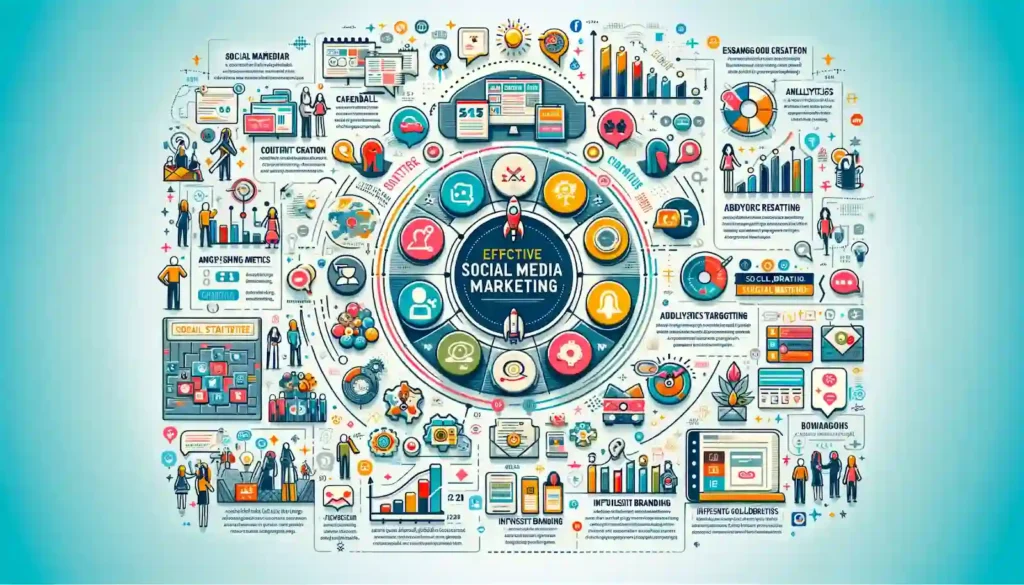Page Contents
Discover how strategic social media marketing can boost brand visibility, deepen customer connections, and drive business growth with real-world examples and expert insights.
Social media marketing has come a long way since its humble beginnings. Think back to the early days of platforms like MySpace and Friendster, when businesses were just starting to dip their toes into the world of online promotion. Fast-forward to today, and social media optimization services have become a powerhouse in the business world, revolutionizing how companies connect with their audience.
In this blog, we’ll dive deep into the world of social media marketing, exploring its impact on business growth and providing actionable insights for success. From understanding the basics to mastering advanced strategies, we’ll cover everything you need to know to unleash the full potential of social media for your business.
Statistics and Trends: How Social Media Is Shaping Consumer Behavior
The numbers don’t lie: social media has become integral to consumers’ daily lives. According to recent studies, the average person spends over 2 hours daily on social media, increasing usage yearly. From discovering new products to seeking recommendations from friends and influencers, consumers turn to social media for everything from inspiration to purchase decisions.

Key Strategies for Effective Social Media Marketing
1. Identifying Your Target Audience
One of the first steps in leveraging social media optimization services is identifying your target audience. Who are you trying to reach with your message? What are their interests, demographics, and behaviors? Understanding your audience can tailor your content to resonate with them and increase engagement.
2. Choosing the Right Social Media Platforms
Not all social media platforms are created equal, and choosing the ones that align with your target audience and business objectives is essential. For example, if you’re targeting a younger demographic, platforms like Instagram and TikTok may be more effective than LinkedIn or Twitter. Take the time to research each platform’s demographics, features, and advertising options to make informed decisions.
3. Crafting Compelling Content: Tips and Best Practices
Content is king in the world of social media marketing, and creating compelling, high-quality content is key to capturing your audience’s attention. Whether it’s eye-catching visuals, informative blog posts, or entertaining videos, focus on creating content that adds value to your audience’s lives and encourages engagement. Don’t be afraid to experiment with different formats and styles to see what resonates best with your audience.
4. Utilizing Visuals and Multimedia for Engagement
They say a picture is worth a thousand words; nowhere is that more true than on social media. Visual content, such as photos, videos, and infographics, tends to perform better than text-only posts, so make sure to incorporate visuals into your social media strategies. Whether you’re showcasing your products, sharing behind-the-scenes glimpses of your business, or telling stories through video, visual content can help you stand out in a crowded feed.
5. The Role of Hashtags and Trending Topics
Hashtags are a powerful tool for increasing the visibility of your social media posts and reaching a broader audience. By including relevant hashtags in your posts, you can make it easier for users to discover your content and join relevant conversations. Keep an eye on trending topics and hashtags in your industry and incorporate them into your posts when appropriate to capitalize on current events and conversations.

Overcoming Challenges in Social Media Marketing
In this section, we will discuss overcoming challenges in social media marketing. We’ll cover strategies for dealing with negative feedback and crisis management, managing time and resources effectively, and adapting to algorithm changes and platform updates to maintain visibility and engagement.
1- Dealing with Negative Feedback and Crisis Management
In the world of social media, negative feedback, and crises can arise unexpectedly and threaten your brand’s reputation. Whether it’s a customer complaint gone viral or a PR nightmare, it’s essential to have a plan in place for dealing with these situations. Respond promptly, empathetically, and transparently to address concerns and mitigate damage to your brand’s reputation. By staying calm, proactive, and honest, you can turn a negative situation into an opportunity to showcase your commitment to customer satisfaction and transparency.
2- Managing Time and Resources Effectively
With so many social media platforms and endless content possibilities, managing time and resources effectively can be challenging. To avoid burnout and maximize productivity, prioritize tasks, set realistic goals, and automate repetitive processes wherever possible. Invest in tools and resources that streamline your workflow and empower your team to work smarter, not harder. By focusing on high-impact activities and optimizing your processes, you can make the most of your time and resources and achieve better results on social media.
3- Adapting to Algorithm Changes and Platform Updates
Social media platforms constantly evolve, and staying ahead of algorithm changes and platform updates is essential for maintaining visibility and engagement. Keep a close eye on industry news and platform announcements to stay informed about changes that may impact your strategy. Experiment with different content formats, posting times, and engagement tactics to adapt to algorithm changes and ensure your content remains visible and relevant to your audience. By staying agile and proactive, you can navigate the ever-changing landscape of social media marketing and stay ahead of the curve.
Integrating Social Media Marketing with Overall Business Strategy
In this section, we will discuss aligning social media goals with business objectives to drive tangible results. We’ll explore the importance of collaboration across marketing, sales, and customer service departments to create cohesive campaigns. Additionally, we’ll cover the benefits of incorporating user-generated content and influencer partnerships to amplify efforts and foster authentic audience connections.
▪️ Aligning Social Media Goals with Business Objectives
Successful social media marketing isn’t just about gaining likes and followers and driving tangible business results. You can ensure that your efforts contribute directly to your bottom line by aligning your social media goals with your overall business objectives. Whether you want to increase brand awareness, drive website traffic, or boost sales, make sure your social media strategy supports your broader business goals.
▪️ Collaboration Across Departments: Marketing, Sales, Customer Service
Effective social media marketing requires collaboration across departments, including marketing, sales, and customer service. By breaking down silos and fostering open communication, you can ensure that everyone is aligned on messaging, goals, and priorities. Encourage cross-functional collaboration and empower teams to work together to create cohesive, integrated campaigns that deliver results across the entire customer journey.
▪️ Incorporating User-Generated Content and Influencer Partnerships
User-generated content and influencer partnerships can be powerful tools for amplifying your social media marketing efforts. Encourage your audience to create and share content related to your brand, product, or service, and leverage influencer partnerships to reach new audiences and build credibility. By harnessing the power of user-generated content and influencer marketing, you can create authentic connections with your audience and drive meaningful engagement and advocacy.
Key Takeaways
Integrating social media marketing with your overall business strategy is essential for driving meaningful results and staying ahead of the curve in today’s digital world. By aligning your social media goals with your broader business objectives, fostering collaboration across departments, and embracing emerging trends and technologies, you can unlock new opportunities for growth and success. Take action, implement strategies, and harness the transformative power of social media marketing to propel your business forward in the digital age.
FAQs
Q1- How Businesses Use Social Media for Marketing?
Businesses use social media for marketing by:
1. Content Creation: Posting valuable content (videos, blogs, images) to engage their audience.
2. Paid Advertising: Running targeted ad campaigns to reach specific demographics.
3. Influencer Partnerships: Collaborating with influencers to promote products.
4. Customer Interaction: Engaging with customers through comments, messages, and live sessions.
5. Analytics: Tracking performance metrics to optimize strategies.
6. Brand Awareness: Building a strong online presence and brand identity.
Q2-What Is the Impact of Social Media Marketing on Small Business Growth?
Social media marketing impacts small business growth by:
1. Increased Visibility: Expands reach to a larger audience.
2. Customer Engagement: Builds stronger relationships with customers.
3. Cost-Effective Advertising: Provides affordable promotion options.
4. Brand Awareness: Enhances brand recognition and loyalty.
5. Sales Growth: Drives traffic and boosts sales through targeted campaigns.
6. Competitive Advantage: Helps small businesses compete with larger companies.







This Post Has One Comment
I’ve been surfing online more than 3 hours today, yet I never found any interesting article like yours.
It is pretty worth enough for me. In my view, if all webmasters and bloggers made good content as you did,
the internet will be much more useful than ever before.